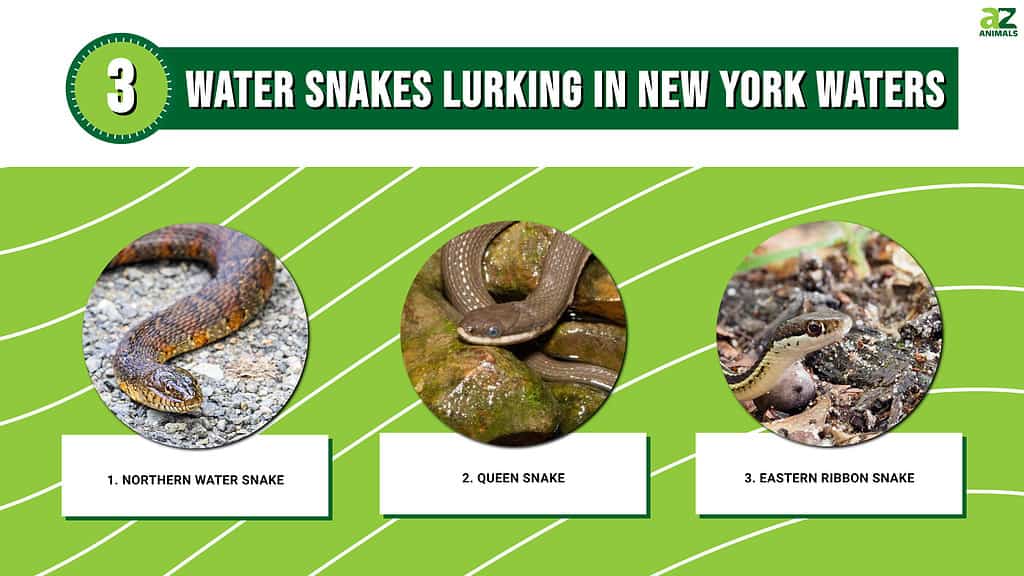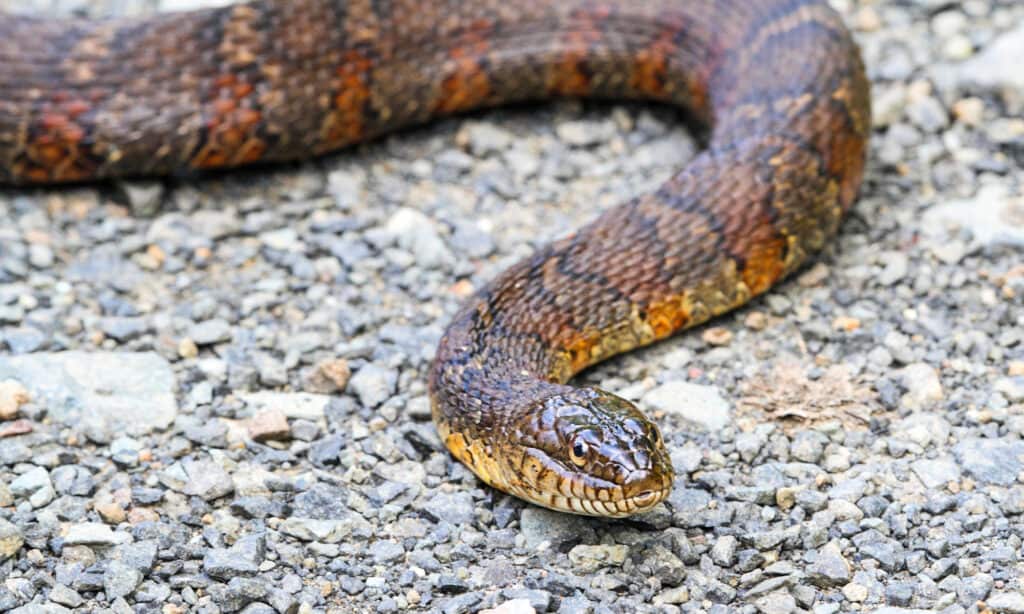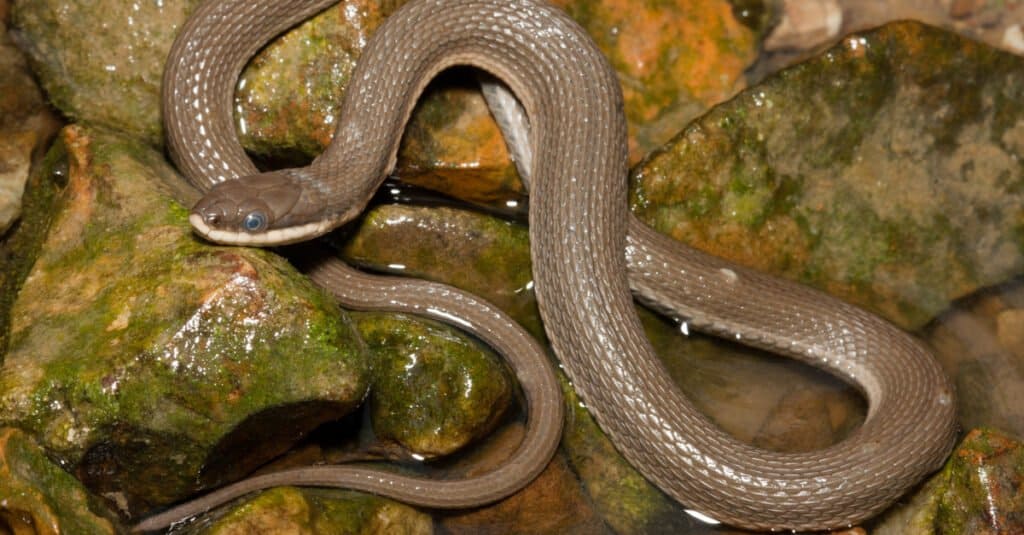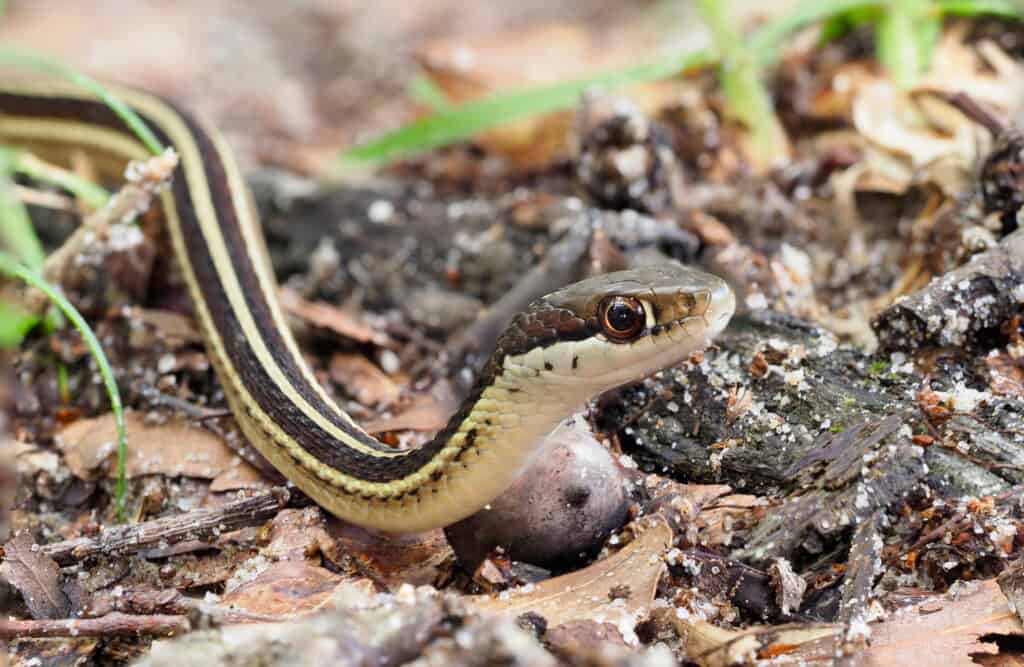Although New York is famous for its urban landscape, it’s also well known for its vast network of lakes and rivers. In fact, 13.6% of New York’s entire area is water, with the Hudson River, Lake Erie, and Lake Ontario just a few of the major areas. Therefore, you probably won’t be surprised to find numerous aquatic and semi-aquatic animals in the state — including snakes! There are 17 species of snakes in New York, and three of these can be found lurking in the water. Thankfully, none of them are venomous, but it’s still a good idea to know which ones you might encounter. So, let’s discover everything you need to know about the water snakes in New York!

1. Northern Water Snake (Nerodia sipedon)
First, we have the one true water snake in New York — the northern water snake. Northern water snakes are the most common water snake in the state. They are widely distributed across the state in all but the most northern counties. Northern water snakes live in virtually all freshwater habitats but do show a preference for slow-moving water such as marshes, ponds, and lakes. They can sometimes be observed basking on rocks on the shore or hanging from overhanging vegetation, but they rarely ever stray far from water. Lake Erie, in particular, is home to a large population of northern water snakes. Although the nominate subspecies is the ones that occur in New York waters, there’s another subspecies — the Lake Erie water snake — which lives at the western end of the lake.
Northern water snakes are large, powerful animals and typically reach lengths of up to five feet. They have brown to brownish-black bodies with darker crossband markings on their neck and blotches on their body. They have a similar appearance to the venomous cottonmouth snake and are often mistaken for them in areas where they share the same range, although the cottonmouth does not inhabit New York. However, despite not being venomous, the northern water snake is still a dangerous snake as it is highly aggressive and will repeatedly strike when threatened. As well as having sharp teeth, these snakes have an anti-coagulant in their saliva. This causes wounds to bleed a lot, preventing the blood from clotting properly.
Northern water snakes are primarily diurnal and are active between March and October. They are ovoviviparous and give birth to live young in the late summer and early fall.

Northern water snakes are large, powerful animals that typically reach lengths of up to five feet.
©Steve Byland/Shutterstock.com
2. Queen Snake (Regina septemvittata)
The next snake is the semi-aquatic queen snake which lives in shallow, rocky-bottomed streams and ponds. They are a state-endangered species and only occur across a handful of counties in the western region of the state. Queen snakes prey predominantly on crayfish, which they frequently hunt for between and underneath rocks. They are uniquely adapted to their habitat and lifestyle as they have narrow and distinctly flattened heads. This allows them to reach into narrow gaps between rocks in search of their prey. They also have up to nine thick, plate-like scales on the top of their head and several rows of thicker scales underneath their chin. The scales help to protect them against sharp, abrasive rocks.
Queen snakes are 15 to 24 inches long and have slender gray to brown bodies with yellow or cream-colored bellies. They also have up to four dark stripes running along their belly. They also have keeled dorsal scales. Additionally, there are sometimes stripes visible along their back, although these typically fade as the snake ages. The lips are cream-colored and are quite distinctive compared to their brown head. They are not venomous and rarely bite when handled, although they may thrash around.
Queen snakes emerge from brumation in April and are active until October. They are typically active during the day and may occasionally be seen basking near the water’s edge. Like the northern water snake, queen snakes are ovoviviparous and give birth to live young after the eggs have hatched inside the female. Juvenile snakes are typically born between late July and September.

Queen snakes are 15 to 24 inches long and have slender gray to brown bodies with yellow or cream-colored bellies.
©Nathan A Shepard/Shutterstock.com
3. Eastern Ribbon Snake (Thamnophis saurita)
Although the eastern ribbon snake is not technically a water snake, it is commonly found in and around wetland habitats across the state. Their preferred habitats include swamps, marshes, streams, and ponds. Eastern ribbon snakes are highly accomplished swimmers and rarely stray far from water. There are four subspecies of eastern ribbon snakes. Both the nominate subspecies and the northern ribbon snake inhabit New York. Eastern ribbon snakes are typically 18 to 26 inches long with slender bodies. They have a brown to black ground color with three distinctive yellowish-colored stripes — one down their back and one on each side. They also have keeled dorsal scales.
Eastern ribbon snakes also rely heavily on water for their food source. They prey predominantly on small fish, frogs, toads, newts, and salamanders. Eastern ribbon snakes are neither venomous nor constrictors. Instead, they simply grab their prey and swallow it alive. Eastern ribbons snakes also rely on the water as a means of escaping a threat. When they are threatened or disturbed, they quickly flee back into the water rather than reacting aggressively. However, if they are cornered, then they will thrash about and release foul-smelling musk as a defense mechanism.
Eastern ribbon snakes are typically active between April and October. Mating occurs in the spring, and young are born in the late summer to early fall. Although eastern ribbon snakes can remain active all year round if the weather is mild enough, they do typically enter into a state of brumation for the winter. As a result, overwintering often takes place in communal groups in rocky crevices or in abandoned mammal burrows.

Eastern ribbon snakes have a brown to black ground color with three distinctive yellowish-colored stripes — one down their back and one on each side.
©Steve Bower/Shutterstock.com
The photo featured at the top of this post is © Steve Byland/Shutterstock.com
Discover the "Monster" Snake 5X Bigger than an Anaconda
Every day A-Z Animals sends out some of the most incredible facts in the world from our free newsletter. Want to discover the 10 most beautiful snakes in the world, a "snake island" where you're never more than 3 feet from danger, or a "monster" snake 5X larger than an anaconda? Then sign up right now and you'll start receiving our daily newsletter absolutely free.
Thank you for reading! Have some feedback for us? Contact the AZ Animals editorial team.






